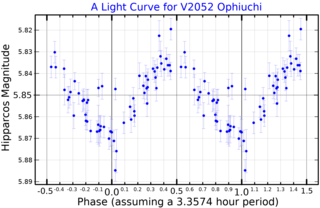Related Research Articles

Gamma Pegasi is a star in the constellation of Pegasus, located at the southeast corner of the asterism known as the Great Square. It has the formal name Algenib ; the Bayer designation Gamma Pegasi is Latinized from γ Pegasi and abbreviated Gamma Peg or γ Peg. The average apparent visual magnitude of +2.84 makes this the fourth-brightest star in the constellation. The distance to this star has been measured using the parallax technique, yielding a value of roughly 470 light-years.

Delta Scuti, Latinized from δ Scuti, is a variable star in the southern constellation Scutum. With an apparent visual magnitude that fluctuates around 4.72, it is the fifth-brightest star in this small and otherwise undistinguished constellation. Analysis of the parallax measurements place this star at a distance of about 199 light-years from Earth. It is drifting closer with a radial velocity of −45 km/s.
Beta Cephei variables, also known as Beta Canis Majoris stars, are variable stars that exhibit small rapid variations in their brightness due to pulsations of the stars' surfaces, thought due to the unusual properties of iron at temperatures of 200,000 K in their interiors. These stars are usually hot blue-white stars of spectral class B and should not be confused with Cepheid variables, which are named after Delta Cephei and are luminous supergiant stars.

Upsilon Orionis (υ Ori, υ Orionis) is a star in the constellation Orion. It has the traditional name Thabit or Tabit (ﺛﺎﺑﺖ, Arabic for "the endurer"), a name shared with Pi3 Orionis. It is a blue-white main sequence star of apparent magnitude 4.62 located over 3000 light-years distant from the Solar System. It is a suspected Beta Cephei variable.
42 Camelopardalis is a single star in the constellation Camelopardalis, located roughly 770 light years away from the Sun. It is visible to the naked eye as a faint, blue-white hued star with an apparent visual magnitude of 5.14. The visual magnitude of the star is diminished by an extinction of 0.22 due to interstellar dust. It is moving further from the Earth with a heliocentric radial velocity of 3 km/s. 42 Camelopardalis has a peculiar velocity of 24.4+1.9
−2.1 km/s and may be a runaway star.

W Cephei is a spectroscopic binary and variable star located in the constellation Cepheus. It is thought to be a member of the Cep OB1 stellar association at about 8,000 light years. The supergiant primary star is one of the largest known stars and as well as one of the most luminous red supergiants.

DL Crucis is a variable star in the constellation Crux.

3 Vulpeculae is a binary star system in the northern constellation of Vulpecula, located around 366 light years away from the Sun. 3 Vulpeculae is its Flamsteed designation. It is visible to the naked eye as a faint, blue-white hued star with a baseline apparent visual magnitude of 5.18.

V381 Cephei is a triple star system in the northern constellation of Cepheus. Its apparent magnitude is slightly variable between 5.5 and 5.7.
Zeta Circini, Latinized from ζ Circini, is the Bayer designation for a star located in the southern constellation of Circinus. With an apparent visual magnitude of 6.08, it is barely visible to the naked eye on a dark night. The distance to this star, as estimated using an annual parallax shift of 2.56 mas, is around 1,300 light years.

1 Camelopardalis is a double star system in the constellation Camelopardalis. Its combined apparent magnitude is 5.56 and it is approximately 800 parsecs (2,600 ly) away.

Omega1 Cygni, Latinized from ω1 Cygni, is the Bayer designation for a solitary star in the northern constellation of Cygnus. It is visible to the naked eye with an apparent visual magnitude of 4.94. Based upon an annual parallax shift of 2.59 mas, it is estimated to lie roughly 1,260 light years from the Sun. Relative to its neighbors, this star has a peculiar velocity of 25.7±2.2 km/s.

Nu Eridani is a star in the constellation Eridanus. It is visible to the naked eye with an apparent visual magnitude of 3.93. The distance to this star is roughly 520 light years, based upon an annual parallax shift of 0.00625 arcseconds. If the star were 33 ly (10 pc) from the Sun, it would be the brightest star in the night sky with an apparent magnitude of −2.84.

22 Orionis is a binary star in the equatorial constellation of Orion. It has the Bayer designation o Orionis, while 22 Orionis is the Flamsteed designation. This system is visible to the naked eye as a faint, blue-white hued star with an apparent visual magnitude of 4.74. It is located approximately 1,100 light years away from the Sun based on parallax. The system is moving further from the Earth with a heliocentric radial velocity of +28.80

53 Persei is a single variable star in the northern constellation of Perseus. It has the Bayer designation d Persei, while 53 Persei is the Flamsteed designation. The star is visible to the naked eye as a faint, blue-white hued point of light with an apparent visual magnitude of 4.80. It is located approximately 480 light years away from the Sun, as determined from parallax, and is drifting further away with a radial velocity of +7.3 km/s.

30 Piscium is a solitary variable star in the zodiac constellation of Pisces. It is visible to the naked eye with an apparent visual magnitude of 4.37. Its calculated mid-value of antiposed parallax shift as the Earth moves around the Sun of very roughly 7.88 mas, makes it around 410 light years away. Its net movement in the present epoch is one of moving closer – radial velocity is −12 km/s.

V4199 Sagittarii is a variable star in the southern constellation of Sagittarius. It is a dim star that is just visible to the naked eye with an apparent visual magnitude that varies between 6.22 and 6.28 over a period of 1.23825 days. The star is located at a distance of approximately 689 light years from the Sun based on parallax, but is drifting closer with a radial velocity of roughly −23 km/s. It has an absolute magnitude of −0.63, on average.

A slowly pulsating B-type star (SPB), formerly known as a 53 Persei variable, is a type of pulsating variable star. They may also be termed a long-period pulsating B star (LPB). As the name implies, they are main-sequence stars of spectral type B2 to B9 that pulsate with periods between approximately half a day and five days, however within this most member stars have been found to have multiple periods of oscillations. They display variability both in their light emission and in their spectral line profile. The variations in magnitude are generally smaller than 0.1 magnitudes, making it quite hard to observe variability with the naked eye in most cases. The variability increases with decreasing wavelength, thus they are more obviously variable in ultraviolet spectrum than visible light. Their pulsations are non-radial, that is, they vary in shape rather than volume; different parts of the star are expanding and contracting simultaneously.

12 Lacertae is a wide binary star system in the northern constellation of Lacerta, located roughly 1,260 light years away from the Sun based on parallax. It is visible to the naked eye as a dim, blue-white hued point of light with a baseline apparent visual magnitude of 5.23. The system is drifting closer to the Earth with a mean heliocentric radial velocity of –12.5. It is a probable member of the I Lacertae OB association.

V2052 Ophiuchi, also known as HR 6684, is a star about 920 light years from Earth in the constellation Ophiuchus. It is a 5th-magnitude star, making it faintly visible to the naked eye of an observer far from city lights. V2052 Ophiuchi is a Beta Cephei variable star, varying slightly in brightness from magnitude 5.81 to 5.84 over a period of about 3.4 hours.
References
- 1 2 3 4 5 Vallenari, A.; et al. (Gaia collaboration) (2023). "Gaia Data Release 3. Summary of the content and survey properties". Astronomy and Astrophysics. 674: A1. arXiv: 2208.00211 . Bibcode:2023A&A...674A...1G. doi: 10.1051/0004-6361/202243940 . S2CID 244398875. Gaia DR3 record for this source at VizieR.
- 1 2 3 Otero, S. A (21 November 2012). "AG Piscium". AAVSO Website. American Association of Variable Star Observers . Retrieved 5 July 2014.
- ↑ Rountree Lesh, Janet (1968). "The Kinematics of the Gould Belt: An Expanding Group?". The Astrophysical Journal Supplement Series. 17: 371. Bibcode:1968ApJS...17..371L. doi: 10.1086/190179 .
- 1 2 Crawford, D. L.; Barnes, J. V.; Golson, J. C. (1971). "Four-color, Hbeta, and UBV photometry for bright B-type stars in the northern hemisphere". The Astronomical Journal. 76: 1058. Bibcode:1971AJ.....76.1058C. doi:10.1086/111220.
- ↑ Gontcharov, G. A. (2006). "Pulkovo Compilation of Radial Velocities for 35 495 Hipparcos stars in a common system". Astronomy Letters. 32 (11): 759–771. arXiv: 1606.08053 . Bibcode:2006AstL...32..759G. doi:10.1134/S1063773706110065. S2CID 119231169.
- ↑ Hubrig, S.; Briquet, M.; Scholler, M.; De Cat, P.; Mathys, G.; Aerts, C. (2006). "Discovery of magnetic fields in the Cephei star 1 CMa and in several slowly pulsating B stars". Monthly Notices of the Royal Astronomical Society: Letters. 369 (1): L61–L65. arXiv: astro-ph/0604283 . Bibcode:2006MNRAS.369L..61H. doi: 10.1111/j.1745-3933.2006.00175.x . S2CID 18201908.
- ↑ de Cat, P. (2007). "Observational Asteroseismology of slowly pulsating B stars". Communications in Asteroseismology. 150: 167–74. Bibcode:2007CoAst.150..167D. doi: 10.1553/cia150s167 .